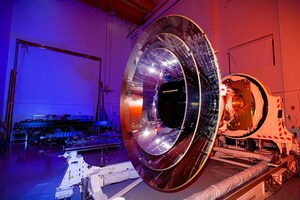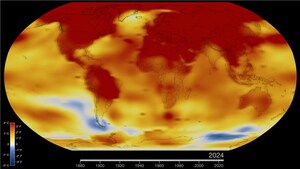WASHINGTON, May 22, 2018 /PRNewswire-USNewswire/ -- A joint U.S./German space mission to track the continuous movement of water and other changes in Earth's mass on and beneath the planet's surface successfully launched at 12:47 p.m. PDT Tuesday from the California coast.
The twin spacecraft of the Gravity Recovery and Climate Experiment Follow-On (GRACE-FO), a joint NASA/German Research Centre for Geosciences (GFZ) mission, lifted off on a SpaceX Falcon 9 rocket from Space Launch Complex 4E at Vandenberg Air Force Base in California, sharing their ride into space with five Iridium NEXT communications satellites.
Ground stations have acquired signals from both GRACE-FO spacecraft. Initial telemetry shows the satellites are performing as expected. The GRACE-FO satellites are at an altitude of about 305 miles (490 kilometers), traveling about 16,800 mph (7.5 kilometers per second). They are in a near-polar orbit, circling Earth once every 90 minutes.
"GRACE-FO will provide unique insights into how our complex planet operates," said Thomas Zurbuchen, associate administrator of NASA's Science Mission Directorate at NASA Headquarters. "Just as important, because the mission monitors many key aspects of the Earth's water cycle, GRACE-FO data will be used throughout the world to improve people's lives – from better predictions of drought impacts to higher quality information on use and management of water from underground aquifers."
Over its five-year mission, GRACE-FO will monitor the movement of mass around our planet by measuring where and how the moving mass changes Earth's gravitational pull. The gravity changes cause the distance between the two satellites to vary slightly. Although the two satellites orbit 137 miles (220 kilometers) apart, advanced instruments continuously measure their separation to within the width of a human red blood cell.
GRACE-FO continues the U.S./German partnership of the original GRACE mission, which operated from 2002 through 2017. "This mission continues and advances an amazing achievement of science and technology pioneered by the United States and Germany," said Zurbuchen.
For 15 years, GRACE's monthly maps of regional gravity variations provided new insights into how the Earth system functions and responds to change.
Among its innovations, GRACE was the first mission to measure the amount of ice being lost from the Greenland and Antarctic ice sheets. The mission improved our understanding of the processes responsible for sea level rise and ocean circulation, provided insights into where global groundwater resources are shrinking or growing, showed where dry soils are contributing to drought, and monitored changes in the solid Earth, such as from earthquakes.
Frank Webb, GRACE-FO project scientist at NASA's Jet Propulsion Laboratory (JPL) in Pasadena, California, notes that to understand changes taking place in the climate system, scientists need data records several decades long.
"Extending the data record from GRACE will allow us to better distinguish short-term variability from longer-term trends," he said.
The GRACE-FO satellites will spend their first few days in space moving to the separation distance needed to perform their mission. When they reach this distance, the mission begins an 85-day, in-orbit checkout phase. Mission managers will evaluate the instruments and satellite systems and perform calibration and alignment procedures. Then the satellites will begin gathering and processing science data. The first science data are expected to be released in about seven months.
JPL manages the GRACE-FO mission for NASA's Science Mission Directorate in Washington, under the direction of the Earth Systematic Missions Program Office at NASA's Goddard Space Flight Center in Greenbelt, Maryland. The spacecraft were built by Airbus Defence and Space in Friedrichshafen, Germany, under subcontract to JPL. GFZ contracted GRACE-FO launch services from Iridium. GFZ subcontracted mission operations to the German Aerospace Center (DLR), which operates the German Space Operations Center in Oberpfaffenhofen, Germany.
For more information about GRACE-FO, visit:
SOURCE NASA
Related Links
WANT YOUR COMPANY'S NEWS FEATURED ON PRNEWSWIRE.COM?
Newsrooms &
Influencers
Digital Media
Outlets
Journalists
Opted In






Share this article